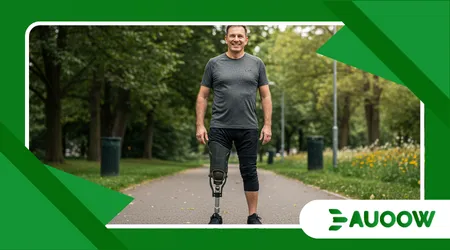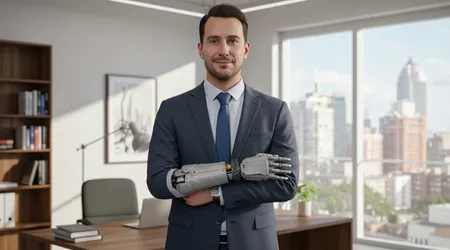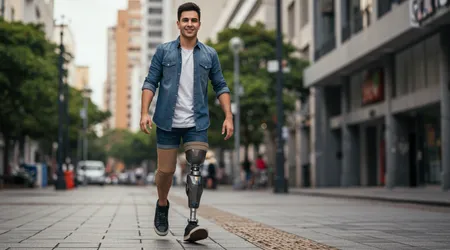3D-Printed Prosthetics: Custom Accessibility for All

3D-printed prosthetics are transforming lives, offering affordable, tailored solutions for millions. Once a niche technology, additive manufacturing now empowers amputees with unprecedented customization.
From bionic arms to lightweight leg braces, this innovation bridges gaps in accessibility, affordability, and functionality.
In 2025, advancements in materials and AI integration have made 3D-printed prosthetics a cornerstone of assistive technology, reshaping how we view disability and rehabilitation.
This blog dives into the revolution, exploring its impact, challenges, and future, with real-world examples and cutting-edge insights.
Imagine a world where a child in a remote village can receive a custom prosthetic hand in days, not months. That’s the promise of 3D-printed prosthetics.
This technology isn’t just about replacing limbs it’s about restoring dignity, independence, and opportunity.
Why should anyone wait years for a device that fits their unique needs? Let’s unpack how this game-changing innovation is making accessibility a reality for all.
The Evolution of Prosthetic Design
Traditional prosthetics, often handmade, were costly and time-intensive. Skilled artisans used plaster casts, requiring weeks of labor.
3D-printed prosthetics slash production time dramatically. Using CAD software, designers create precise digital models, printed layer by layer. This shift, driven by expiring patents, democratized access to advanced tools.
The process begins with 3D scanning, capturing exact limb dimensions. Unlike standardized designs, 3D-printed prosthetics ensure a perfect fit.
++ AI-Powered Eye Movement Tools for Nonverbal Users: What’s New
A 2023 study by Beygi and Wong found 3D-printed spinal braces outperformed traditional ones in user satisfaction. Customization enhances comfort, reducing adjustment needs significantly.
Moreover, 3D-printed prosthetics allow rapid prototyping. Clinicians can test designs quickly, incorporating patient feedback.
This iterative approach improves outcomes, especially for children who outgrow devices. The result? Devices that evolve with the user’s needs.

Affordability and Global Reach
Cost has long barred access to quality prosthetics. Traditional devices can exceed $50,000, unaffordable for many.
3D-printed prosthetics cut costs by up to 80%. Using materials like PLA, production becomes scalable and budget-friendly.
In low-resource settings, this is revolutionary. NGOs like e-NABLE have delivered over 8,000 3D-printed prosthetics globally.
Volunteers design hands for children, printed locally, reducing logistical barriers. Accessibility is no longer a privilege but a possibility.
Also read: How Tech Conferences Are Becoming More Inclusive
Take Aisha, a 12-year-old in Kenya. After losing her arm, she received a 3D-printed hand from a local hub. Within days, she was writing again. This affordability empowers communities, breaking cycles of exclusion.
Material Innovation and Functionality
Material advancements elevate 3D-printed prosthetics. Biocompatible polymers like PEEK and titanium alloys enhance durability.
These materials mimic natural structures, improving functionality. Flexible filaments allow dynamic movement, crucial for daily tasks.
AI integration optimizes designs. Algorithms analyze CT scans, ensuring precise fits. For example, bionic limbs with brain-hand communication offer natural movements. Such innovations redefine what prosthetics can achieve.
Read more: Inclusive Gaming: How Developers Are Building for Everyone
Consider Jake, a veteran who received a 3D-printed bionic arm. Embedded sensors allow him to grip objects delicately. This fusion of materials and tech transforms lives, blending form with function.
Challenges in Scaling the Technology
Despite progress, 3D-printed prosthetics face hurdles. Standardization remains elusive, complicating regulatory approval.
Inconsistent material bonding in FDM printing weakens components. Robust quality control is essential but underdeveloped.
Infrastructure gaps hinder global adoption. Many regions lack reliable 3D printers or trained technicians. Regulatory bodies struggle to keep pace with rapid advancements, delaying approvals. Collaboration is critical to overcome these barriers.
Interdisciplinary teams engineers, clinicians, and patients must align. Without this, 3D-printed prosthetics risk falling short of their potential. Ongoing research is vital to establish evidence-based practices for widespread use.
The Role of AI and Emerging Technologies
AI is reshaping 3D-printed prosthetics. Machine learning predicts device performance, enhancing durability.
AI-driven imaging creates precise models from medical scans. This ensures implants integrate seamlessly with the body.
Emerging 4D printing introduces shape-changing materials. These adapt to user movements, offering dynamic support.
QBioprinting, using living cells, promises tissue-like prosthetics. Such innovations could redefine rehabilitation by 2030.
For instance, researchers at Caltech are exploring ultrasound-based 3D printing. Liquid gels solidify into custom shapes inside the body.
This could revolutionize implant precision, pushing boundaries beyond current capabilities.
Ethical and Social Implications

Accessibility raises ethical questions. Should 3D-printed prosthetics prioritize aesthetics or function?
Cultural stigmas around disability influence design choices. In some communities, visible prosthetics empower, while others prefer discreet devices.
Equitable access is another concern. While costs drop, training and infrastructure lag in rural areas. Inclusive design must consider diverse needs children, athletes, or elderly users. Empowerment starts with understanding these nuances.
Storytelling, as seen in AT2030 programs, amplifies user voices. Workshops in Kenya empower amputees to advocate for better access.
This human-centered approach ensures technology serves real-world needs, not just innovation for its sake.
A Table of Impact: 3D Printing in Prosthetics
| Aspect | Traditional Prosthetics | 3D-Printed Prosthetics |
|---|---|---|
| Cost | $10,000–$50,000 | $500–$5,000 |
| Production Time | Weeks to months | Hours to days |
| Customization | Limited, manual adjustments | Highly precise, digital |
| Material Options | Standard metals, plastics | Biocompatible, flexible |
| Accessibility | Restricted to high-income | Global, scalable |
Source: Adapted from e-NABLE and TechMed 3D data, 2023–2025.
The Future of 3D-Printed Prosthetics
By 2030, 3D-printed prosthetics could integrate fully with neural systems. Brain-computer interfaces may enable seamless control.
Imagine a prosthetic hand responding to thoughts as naturally as a real one. This is no longer science fiction.
Sustainability is another frontier. Recycled polymers and eco-friendly materials are gaining traction. NASA’s use of 3D printing for space tools hints at scalable, sustainable solutions. Prosthetics could follow suit, reducing environmental impact.
Collaborative ecosystems will drive progress. Universities, startups, and NGOs are already partnering.
The Cyborg Beast hand, developed by Jorge Zuniga, exemplifies how open-source designs accelerate innovation. The future lies in shared knowledge.
Analogy: A Tailor for the Body
Think of 3D-printed prosthetics as a master tailor crafting a bespoke suit. Just as a tailor measures every curve for a perfect fit, 3D printing molds devices to the body’s unique contours.
This precision ensures comfort, functionality, and confidence, stitching together a new chapter of independence for users.
FAQs: 3D-Printed Prosthetics
Q: How affordable are 3D-printed prosthetics compared to traditional ones?
A: They can cost 80% less, often ranging from $500–$5,000, making them accessible globally.
Q: Are 3D-printed prosthetics durable enough for daily use?
A: Yes, with materials like PEEK and titanium alloys, they offer comparable or superior durability.
Q: Can children use 3D-printed prosthetics?
A: Absolutely. Rapid prototyping allows devices to be resized as children grow, ensuring long-term fit.
Q: What are the main challenges in adopting this technology?
A: Standardization, infrastructure gaps, and regulatory delays remain significant hurdles.
Q: How does AI enhance 3D-printed prosthetics?
A: AI optimizes designs, predicts performance, and ensures precise fits using medical imaging data.
In 2025, 3D-printed prosthetics are more than a technological marvel they’re a movement. From Aisha’s hand in Kenya to Jake’s bionic arm, these devices restore more than mobility; they revive hope.
As AI, 4D printing, and sustainable materials converge, the future promises even greater inclusivity. The question isn’t whether this technology will change lives it’s how many more lives we can transform by scaling it responsibly.
